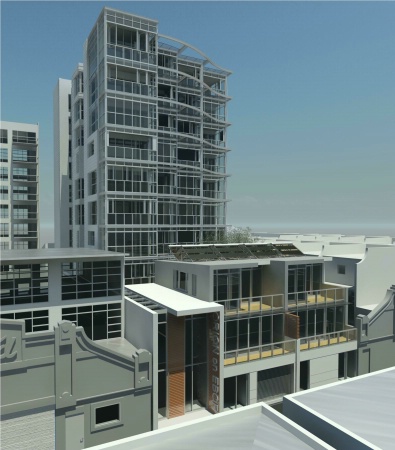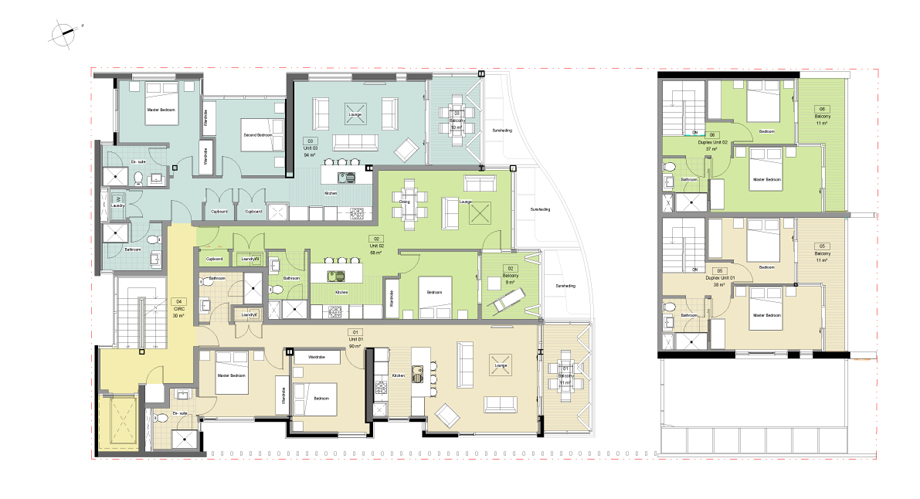The whole topic of Fat Ladies vs Fat Laddies brings up discussion whether either are more suitable for denoting the End of the Boom – and not (given that Opera is such a high money thing that booms in a boom and busts in a bust) the End of the Recession.
So while in the prior posting we may not have got around to the main subject of what may be the Fat Lady of Architecture (one could cruelly say Zaha Hadid): none the less, I’m going to put out there one proposition: Apartments are an indicator to our recovery.
The buying and selling of Individual houses are an indicator of the state of the economy that is taken far more seriously in NZ than it should be. The Reserve Bank is tasked with controlling the economy by the sole means of raising or lowering the interest rate – which, given that most New Zealanders are on fixed rates, has a predictably pathetic effect on the outcome. People will, or won’t, buy individual houses not because of minute shifts in the interest rate, but because they want to start a home, have children, and otherwise move to the suburbs.
But apartments are different. Funded not by home owners but largely by bankers, the launch of an apartment building is an indicator that there is money in the market again. Not, perhaps, for Donald Stott and the ill-fated Watermark development (We’re Bucking the Trend – Yeah Right!) who is now selling up another development of his to pay his bills on the Watermark (according to page C9 of the weekend DomPost). Nor for the Merge Group, who crashed and bombed in nearly every development they attempted, leaving a swathe of derelict sections behind them in Taranaki St, Ghuznee St, and the Hutt.

In the DomPost a week ago though, there is another story. A half page advert launched a “Stellar New Apartment Complex for Downtown Wellington” to be known as Orion on Ebor. This is the first new major apartment development in the Wellington scene for about a year – and so denotes some long-awaited confidence in the market – at least by someone. That someone is not the wide boys of Merge or Land Equity, but the delicately named “Boutique Developments” of a central Wellington chinese family dynasty. Predictably, no such company exists on the Companies Office register, but previous developments by this family include the hideously ugly Galleria on Tory (by ArcHaus), the small and slightly awkward 88 on Tory (by ArcHaus), the Sol apartments (not at all ugly, but with horizontal wings that are just so damn strange! by ArcHaus), and then this: Orion on Ebor (predictably, by ArcHaus).
While normally the naming of an apartment building as “Something On Somewhere” is a sure sign of naffness (Galleria on Tory, Quest on Willis: I rest my case), and traditionally the design of (some) buildings by ArcHaus is a case for cringing: in this case the building has apparently already received Resource Consent and is not half bad at all. Architect Huw Parslow has brought some long awaited good design skills to ArcHaus, having been the lead designer on the Metropol (not a bad scheme even if it was too big, and the developers were too dodgy). Here Parslow has tied the building in to the low building heights of Ebor St (sitting snugly between two heritage Ford ex-warehouse facades), and according to the press release the development was “cited for its design excellence during the resource consent process”.

So: Design excellence? Are these apartments any different from others? What makes them so – and what extra height has been allowed by virtue of their purported design excellence? We’re still to find out. The plans are bigger than recent ArcHaus offerings – but the layout is much the same as other nearby apartments. But while the actual apartments may not be much different, the actual apartment scheme is. Rather than the typical developer approach of cramming a site from wall to wall, the Orion (let’s just drop the ‘On Ebor’ bit already, shall we?) has a small space between front and back, and pulls back slightly from the side boundaries to allow light to slip into the apartments. This is much the same as Arch Plus have done with the Monument, Piermont, and Portal apartments – and probably the Republic as well (currently now underway). The setback from the side allows not only fire rating to take a back seat to light and air, and permits views out – it also permits neighbouring properties – with a bit of squinting – to have a shaft of sunlight through and a viewshaft past. That’s a major move forward – not seen elsewhere in Wellington except in Ebor St (with Sol on one side, and Warren and Mahoney’s Sanctum scheme nearby).
That phrase “Design Excellence” has turned out to be somewhat of a virtual thorn in the all too literal backside of the Council who first admitted that perhaps some buildings could be taller if they exhibited design excellence. Since then, of course, any developer worth their pillar of salt will order their architect to trot the phrase out in the consent application – cynically, one could say that the important thing is to SAY that the building’s design IS excellent, rather than ever just try to design an excellent building to start. Mystery blog commenter ‘in excelsis‘ notes that:
“At first glance, the meaning would seem to be clear enough, in that rather than just being “good design”, which will often imply a modest, well-thought-through solution to a straighforward design problem, “design excellence” suggests a level of creativity, innovation and flair that goes beyond being “just good enough”. However, beyond the fact that one person’s excellence is another’s excrescence, there’s the question of scope. Is it just the external appearance that matters? Or should such things as internal amenity, environmental sustainability, efficiency of planning and structural ingenuity come into it?”
Council’s current rules do indeed go into print over the issue of ‘excellence’. As ‘in excelsis‘ notes, under District Plan rule 12.2.5.5 it says that
“To ensure that over height buildings visually enhance the cityscape of the Central Area, the council will require that they display design excellence”. It goes on to explain that because a building that stands out from its surroundings will be highly visible, it has more responsibility to make a positive visual contribution than one that fits in more modestly to the urban fabric. On the other hand, while not explicitly stated, it would seem that the other aspects of the design must be more than just “good enough”, and some other qualities (such as provision of public amenities) might go towards an understanding of excellence. But since the trigger is height, visibility is the key criterion, and buildings “should display a quality of design that corresponds appropriately to their level of visibility”.
Despite my faith in the panel of urban design experts at the Council, it’s fair to say that Design Excellence is not something you can have a list for – unlike Green Star buildings, where everything has a simple check box. Excellence is one of those things where you will just know it when you see it – but then again, it’s such a subjective opinion. One person’s Beethoven is another person’s Snoop Dogg, if you’ll forgive a musical analogy. And taking that analogy further: while the whole world now seems to be dancing to Mamma Mia and extolling the influence of the excellent Swedes, I’m not sure that I’d want a built equivalent of Abba’s Dancing Queen.

But who’s to say whether or not an Abba would be a good thing? Loved in the 70s by young lovers, laughed at in the 80s, and making a huge comeback in the 90s, Abba’s music is now reaching cult / iconic status – surely a sign of Excellence? Ponder that!
I’ll leave the last quote up to our erudite commentater:
… there’s always a danger of the Council either erring on the side of becoming architectural police or of being swayed by persuasive architects and developers. But while architectural expertise is certainly vital in making the assessment, it’s important to note that it’s _not_ an architectural competition. The underlying criterion is not “is this excellent architecture?”, but “does this building make an excellent contribution to the city?”.




Love the Abba pic
Stratum (Monument/Piermont/Republic) will keep making reasonable apartments come hell or high water and while there is still a number below the 5% of citizens who, I hear, typically live in the central city; there will be a demand for a good place to live centrally.
I’ve heard many young househunters in the past say that they’ve bought reluctantly in the burbs because they felt that the apartment market was overpriced or plain crappy.
While apartments can be more an example of optimism than an expression of confidence they certainly seem that way because they are so obvious on our front doorsteps, as it were.
Meanwhile there are still pockets of activity in suburbia that go less noticed – I’ve yet to see how the subdivision at Owhiro Bay just below Happy Valley Rd pans out but having seen the plans for a hideous $2M mansion extension on Anne St in Wadestown (cast your fishy eyes up above Thorndon from your harbour home and you will see the scars on the hillside), I’m hoping to see some “Design Excellence” downtown because, as some of those househunters know, the burbs can harbour trolls, in the highest degree.
That Abba pic made me think of Will Alsop, for some reason.
really? Which one – the on e in the cape or the hot pants?
Gotta be the cape
Have any of you smart individuals got any backstory on this detail from Alsop’s wiki?
“when he was six years old, he designed a house for his mother to live in – its most striking specification was that it had to be built in New Zealand”
Absolutely no idea or interest in Abba or Alsop, but i do note today’s paper saying that the Recession is officially over. On the basis that consumer confidence was up in both June and again in September, apparently conumers think it is the right time to hit the stores and start spending again.
It would seem to be a very prescient time for an astute apartment developer to launch a project. Well done to your mystery “central Wellington chinese family dynasty” for judging the timing so accurately.
How ’bout this as an architectural forcaster of the economic environment to come…
http://www.guardian.co.uk/artanddesign/2009/oct/13/skyscrapers-signal-downturn